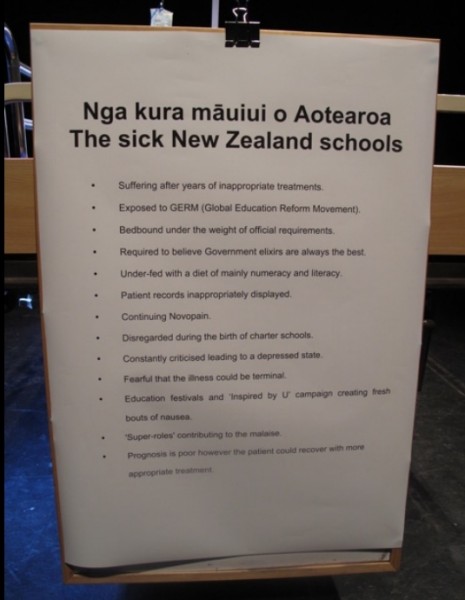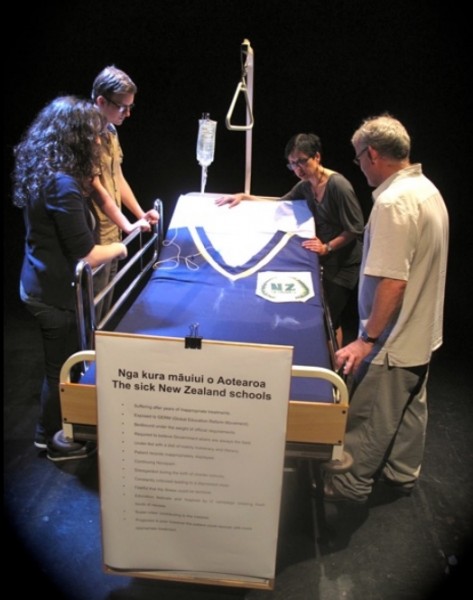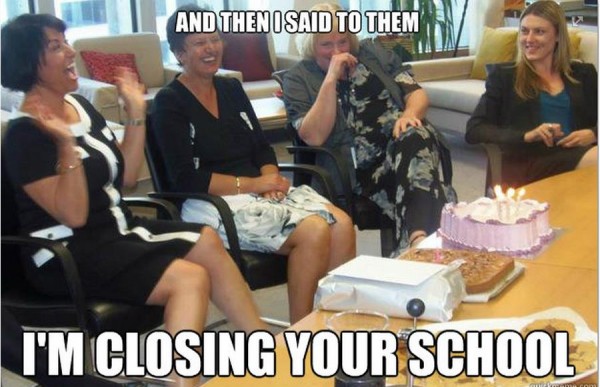This year the Key Government has become unusually upbeat about schools. ‘Festivals of Education’ are celebrating ‘innovations, collaborations and achievements’ within the sector. An ‘Inspired by U’ campaign has been encouraging New Zealanders to write in praise of teachers who have influenced their lives. In January, $359 million of new funding for principal and teacher ‘super-roles’ was announced, the so-called ‘Investing in Educational Success’ policy.
This enthusiasm by the Government comes after five years of being critical of schools and teachers and applying often damaging policies. It also comes in election year and just in advance of an ‘International Summit on the Teaching Profession’ where education ministers, heads of teacher unions and teacher leaders from the OECD are gathering in Wellington. New Zealand’s Education Minister, Hekia Parata, has claimed it is a credit to the quality of our education system that this event is being held in New Zealand.
But this is the reality:
The installation highlights how the Key Government’s education policies are creating a grave situation for the New Zealand school system. The chosen analogy is of New Zealand schools as a hospital patient suffering after years of bad treatment: ‘Ngā kura māuiui o Aotearoa / The sick New Zealand schools’.
Such treatments include having had to put in place the National Standards with their damaging positioning of struggling learners and intensification of staff workloads; loss of professional development quality and opportunities as the work of school advisors has been contracted out and narrowed, the distraction of the (failed) attempt to increase class sizes, disproportionate funding increases for socially-exclusive private schools; integration of some socially-exclusive private schools into the state system so they get government support and can still charge large ‘donations’, allowing wealthy businesspeople to shape the direction of education policy (philanthrocapitalism), and the Christchurch school mergers and closures. There are lots of other problems too and more are discussed in the following slides.
Exposed to GERM (Global Education Reform Movement).
This is about a business model being imposed on New Zealand schools through managerialism, market competition and privatisation. Privatisation of education comes in many forms, both obvious and hidden, including contracting out, PPPs, charter schools and addition support for private schools. It leads to schooling being regarded as a commodity rather than something done for the benefit of each child and for the common good.
Bedbound under the weight of official requirements.
Managerial accountabilities have brought a huge growth of reporting for teachers, principals and Boards of Trustees. Much of this is a waste of precious time that could be beier used working with and for children and young people.
Required to believe Government elixirs are always the best.
There is lack of consultation with those in schools, or consultation only on the detail of policy. Government appointees are taking over from sector or elected representatives and there is the dismissal of research that doesn’t fit with the Government’s objectives.
In 2009 Deputy Prime Minister Bill English said in the House: ‘This Government has the capacity to make its own distinctions between good advice and bad advice. Advice we disagree with is bad advice; advice we agree with is good advice’. We thought he was joking…
Under-fed with a diet of mainly numeracy and literacy.
Many elements of the New Zealand Curriculum are being lost as teachers seek to boost National Standards results in numeracy and literacy. New Zealand schools were already very focused on these areas before the National Standards: now they are often over-emphasising them. The same will probably become true of the effects of Ngā Whanaketanga in Māori-medium schools with the public release of their data.
Patient records inappropriately displayed.
 The 2012 decision to scan National Standards data on to a Government website regardless of format or quality was disgraceful. In that year special schools for children and young people with severe special needs ended up being publicly labelled as 100 ‘well below’. While the Government has taken steps to to ‘fix’ that problem, the wider issues of the quality of the National Standards data and of releasing raw data for each school that cannot illustrate progress have not been addressed. Meanwhile the ‘Public Achievement Information (PAI) Pipeline’ will continue to spew out endless misleading infographics.
The 2012 decision to scan National Standards data on to a Government website regardless of format or quality was disgraceful. In that year special schools for children and young people with severe special needs ended up being publicly labelled as 100 ‘well below’. While the Government has taken steps to to ‘fix’ that problem, the wider issues of the quality of the National Standards data and of releasing raw data for each school that cannot illustrate progress have not been addressed. Meanwhile the ‘Public Achievement Information (PAI) Pipeline’ will continue to spew out endless misleading infographics.
At secondary level, raw NCEA data has also been publicly released for many years. As a nation we have become used to this, but it doesn’t make it acceptable.
Continuing Novopain.
What does the ongoing Novopay debacle say about valuing teachers and other school staff?
Disregarded during the birth of charter schools.
Charter (‘Partnership’) schools will undermine state and integrated schools schools. Charter schools in some ways depend on the state school system but policy also provides charter schools with unfair advantages.
Constantly criticised leading to a depressed state.
Until just recently the Government rarely had anything positive to say about most schools and teachers. The publication of raw achievement data and the setting of arbitrary targets by Government has opened up new opportunities for unfair criticism of schools and teachers from politicians, business leaders and other commentators.
Fearful that the illness could be terminal.
The ‘reorganisation’ of Christchurch schools has resulted in the highly contested closure of schools in that city. It has also raised concerns that schools in other parts of the country will be deemed ‘surplus to requirements’ even if they are important to local communities.
Education festivals and ‘Inspired by U’ campaign creating fresh bouts of nausea.
Recent praise and support from Government is too little, too late. It is hard to take seriously when Government has been failing to listen to those in schools.
‘Super-roles’ contributing to the malaise.
Teachers and principals are justifiably suspicious of the ‘Investing in Educational Success’ proposals announced in January 2014. The training that those in the new roles will receive, the accountabilities they will have, and the extra pay they will get, could provide powerful means of taking greater control over schools to force compliance with damaging policies. This reform also seems to be only part of wider changes to the governance and leadership of schools that are currently underway. There are many more obvious problems as well, such as staff being taken out of school communities that actually require their full-time commitment.
Prognosis is poor – however the patient could recover with more appropriate treatment.
 Careful concern for children and young people and those who teach them needs to be put at the heart of New Zealand education policy. This means policy that genuinely recognises and responds to the diverse contexts within which schools are located and the kinds of children and young people they serve. It also means better professional development for teachers and the appreciation that teachers work within highly collaborative professional cultures and genuinely want to improve their practice.
Careful concern for children and young people and those who teach them needs to be put at the heart of New Zealand education policy. This means policy that genuinely recognises and responds to the diverse contexts within which schools are located and the kinds of children and young people they serve. It also means better professional development for teachers and the appreciation that teachers work within highly collaborative professional cultures and genuinely want to improve their practice.
Education policy also needs to recognise that when teachers are put under the wrong pressures, their teaching becomes less authentic. New Zealand as a small nation is usually a ‘borrower’ rather than a ‘lender’ of education policy. In this situation we need to be taking seriously the extensive research critiques of the policies we are adapting from overseas. Otherwise we are doomed to become just another variant of the educational nightmares to be found in the OECD countries we tend to borrow from.
If overseas visitors attending the ‘International Summit’ want to admire the New Zealand school system, they should be appreciating the long-standing strengths that are holding it together, rather than the impact of the Key Government’s policies.
Acknowledgements:
Installation by Martin Thrupp, Donn Ratana and Viv Aitken, Faculty of Education ,University of Waikato, March 2014. The ‘Ngā kura māuiui’ bed was obtained though a donation to a children’s charity. It was originally used in Tauranga Hospital. Yvonne sewed the ‘school jersey’ beautifully before Donn made it look more lived in. We thank Save our Schools NZ for hosting images and information about our installation.







Well expressed, Dianne. The vital message is that stopping this will take parent and community power. The concerns of education professionals are easily dismissed using the ‘professional capture’ label that originating with the whole neoliberal economics of Milton Friedman and his acolytes e.g. Roger Douglas and Ruth Richardson.
While the notion of ‘professional capture’ has by and large been discredited, this message hasn’t been received by the ‘ideology first, evidence second’ politicians who are running this country to meet their own agenda.
Parents and wider community vote, and that is the voice that politicians can’t ignore.
Odd moment today at the Festival of Education. In Karanga Square there was a big group of young people and whanau celebrating a high energy rough-as-gutts hiphop group from One Tree College and along side this was this hospital bed. I knew what it was because I follow TDB and I shared this post yesterday through my FB. I believe in what Thrupp is saying and I care. But today it was just odd and strangely disconnected.
This hospital bed was random and the message was too abstract for the audience. Ironically inside the festival were speakers talking about how important work conditions for teachers are for quality teaching, the nonsensical nature of performance pay, also there was a youth symposium with young people from all over Auckland (from decile 1 through to decile 10 and private schools) sitting in mixed groups collaborating, debating and posing challenging questions…like a group of students debating the self selected question “What will it take for AGC to introduce Te Reo as a subject?”. This is powerful stuff for democracy. It was not all John Hattie and Minister Parata, in fact today they didn’t feature at all.
The abstract installation type statement being made by this hospital bed totally missed the mark today. The audience who it was meant for weren’t there today and the audience that were there didn’t get it and were probably the choir being preached at.
Sorry, today “The sick New Zealand schools” installation turning up at the Festival of Education gets a thumps down for being too abstract and ill timed. Now if it had been there last night for the gala dinner with all the education celebs walking past it as they arrived…then that would have been a different story.
Sorry a bit of a typo… It was ACG (Auckland Colleges Group) the kids were debating about at the symposia today.
Comments are closed.